A Beginner’s Guide to Starting a Successful Glamping Business
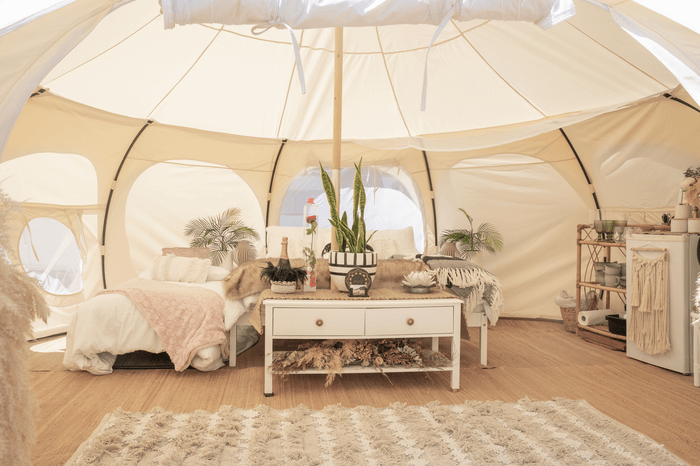
Running a glamping business is rising in popularity among investors and entrepreneurs. As a matter of fact, according to Tents Xpert, the glamping market in the United States is expected to reach a revenue of about $1 billion by 2024. And, there’s no sign of slowing down.
According to Grand View Research, the glamping industry is projected to surpass $5.4 billion by 2028. Though, another report expects it to reach just shy of $4 billion by 2027.
Whichever number you like to believe, it is clear that the global glamping market size is huge and you’ll need a comprehensive glamping business plan in order to make this venture a success.
This impressive growth in the glamping industry is fuelled by travelers’ desire to stay in unique accommodations like a bell tent or glamping pods, while still having access to amenities and services that are not necessarily provided by a traditional camping business. Glamping guests are looking for that traditional luxury feeling but with a unique outdoorsy twist.
Considering this, starting a glamping business as an alternative to traditional vacation rental homes can be an excellent small business opportunity to explore in the next couple of years.
What Is Glamping?
In short, a glamping business is where glamorous accommodations meet traditional camping. Glamping offers accommodations and facilities that are more luxurious compared to ‘bare-bones’ camping, to give travelers the best of both worlds. Successful glamping accommodations mix the feeling of the wonderful outdoors with the amenities of a five-star hotel.

Previously, glamping and luxury camping were seen as a subdivision of traditional camping. Though, nowadays, it is regarded as a type of vacation rental in its own right.
If you’re new to glamping or looking for inspiration to get your glamping site going, watch this video of our latest podcast episode with Chris Jeub on glamping setups and experiences:
Starting a glamping business offers a unique opportunity to combine the beauty of nature with the comforts of modern living. By incorporating luxurious amenities and unique glamping structures, you can create unforgettable experiences for your guests.
What Are The Different Types of Glamping?
If you thought that glamping is only limited to tents and caravans, you would be very much mistaken. From treehouses to tiny houses, various types of accommodation are regarded as glamping structures too. The following are some of the most common examples:
1. Yurts
In short, a yurt is one of the most popular glamping structures. It’s basically a round glamping tent that is made from fabric/animal skin and wooden beams. Originally from Mongolia, it has become a popular feature at festivals for those looking for luxury camping.
Not only is it very accessible, but you can also jazz it up by including amenities like air conditioning — something that your guests will welcome when they’re out and about in the countryside.
2. Tipis (and tents)
A tipi is a traditional, triangular Native American tent. Nowadays, it is made from wooden beams and cotton fabric that are fastened with rope and has become a common sight at campsites.
While it is similar to a yurt, a tipi is simpler and might not offer as much interior space for amenities.
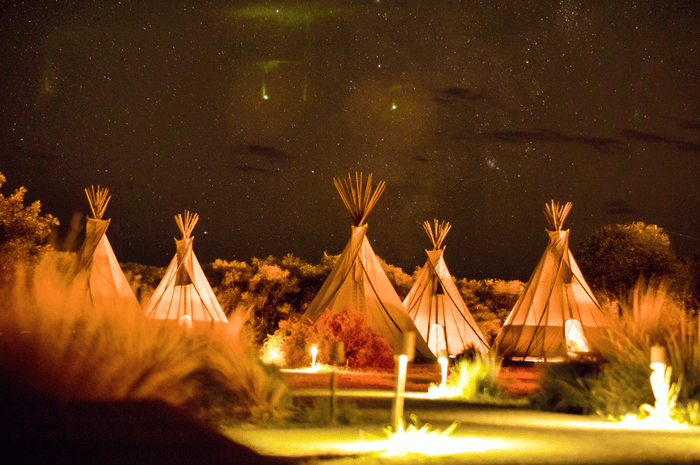
3. Caravans
A caravan is a mobile home that can be towed around by a vehicle, similar to a trailer. It is equipped with the essentials needed for living and provides slightly more space and protection than a traditional tent. It is arguably its versatility that lies behind its popularity over the past couple of decades.
As it is more spacious than some of the other types of accommodation, it is relatively easy to add amenities to boost its appeal.
4. Treehouses
Treehouses are no longer just meant as a hideout for the neighborhood boys. Today, it is also a popular type of glamping. Nature lovers appreciate its sustainable architecture (it is mostly made from wood) and also enjoy how it gives them the chance to explore nature more intimately.
It is also an attractive option for hosts as it offers a long list of options and is quite versatile, similar to caravans.
5. Tiny houses
Tiny houses are currently all the rage. In short, they use limited space and resources making them extremely eco-friendly.
A tiny house is typically situated on a big plot of land and might even be built using ecological materials.
6. Train carriages
If you can get your hands on an old train carriage, it can offer great accommodation to glampers. Though, bear in mind that you won’t be able to use it as is. Before it can be turned into an attractive vacation rental, you will need to remodel and adapt it.
7. Bubble domes
Bubble domes are basically transparent pods. It is a great option if your location is known for its mesmerizing sunrise, sunset, or starry sky.
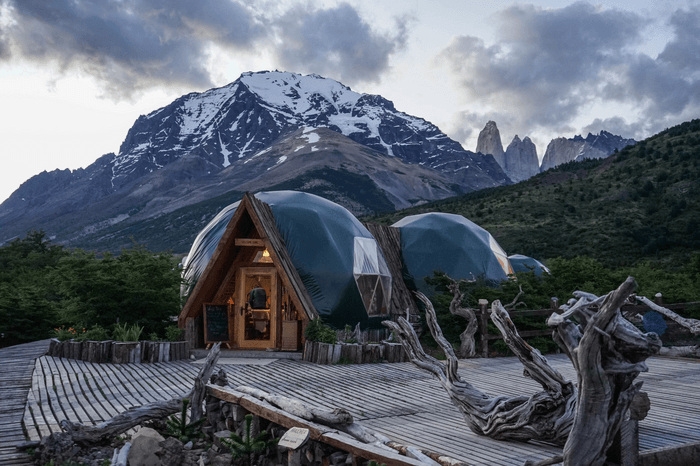
Are Glamping Businesses Profitable as a Vacation Rental Business?
Needless to say, the goal of starting any business is to make a profit. For this to happen, revenue needs to outweigh the costs. Even though there are significant upfront costs involved as you will need to build your accommodation from scratch or modify an existing structure, a glamping business can still be lucrative.
How much does it cost to start a glamping business?
You will need a minimum of around $3,000 to $4,000 to start a glamping business. As mentioned, the most expensive cost will be the glamping tents. That being said, depending on the type of tent you have in mind, you could end up spending $10,000+ just on the tent alone.
Also, if you are not a property owner already, and can’t use your own backyard, you will need to buy or rent land where you can pitch your glamping tent. Ideally, this should be a picturesque, remote area that is still easy to reach. Not only can a remote area work out more affordable, but it is also usually preferred by glampers.
In addition to the tent and land, you will also have the following ongoing expenses:
- Property taxes
- Maintenance costs
- Water
- Electricity
- Furnishings
- Amenities
- Business Insurance
How much do glamping businesses make?
You can make between $40,000 and $250,000 per annum in revenue in the first year that you start a glamping business. The investment range is, on average, $10,050 to $27,600. The profit potential is between $32,000 and $200,000 per annum.
Since you do not need to buy another tent (your biggest expense) and furnishings again in the following year, you can look forward to higher annual revenue and gross income after you’re up and running. This is really when your glamping business makes money.
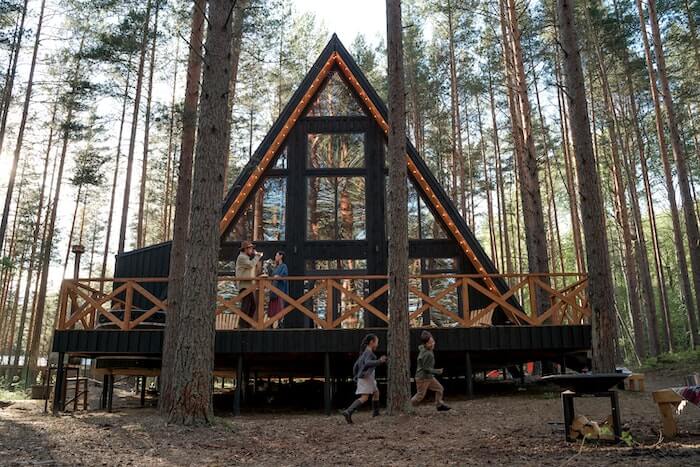
What Are the Advantages of Owning A Glamping Business?
While it might be trending currently, glamping businesses can offer many benefits. So, as a business owner, you can look forward to a positive ROI for years to come.
Lower startup costs
Compared to buying a holiday rental house, glamping tent costs and average furnishing costs are significantly less. It also costs less to maintain your tent and operate a glamping business.
Also, with regard to purchasing land, the best locations for a glamping business are typically in remote areas. These destinations are also less expensive than a popular coastal town or urban area where you will typically find other types of vacation rentals. Of course, this depends on how much land you intend to purchase.
Higher profits
Since the startup and maintenance costs are less, you can expect higher profits. What’s more, you can also expect to see your ROI sooner.
Eco-friendly and celebrates nature
Sustainability is becoming more and more important to consumers and travelers nowadays. Glamping accommodation is typically more eco-friendly than other types of accommodation as organic material and solar panels are often used.
Popular with nature-loving travelers
Since a glamping tent is more often than not situated in remote areas, it is a very popular option among nature lovers. So, you already have a niche market that you can target.
A getaway from the hustle and bustle of big cities
The unique selling proposition of a glamping tent is that they allow travelers to get away from the busy big cities without having to give up all their own lifestyle needs and creature comforts for the trip.
What’s more, this niche is also willing to pay more for the chance to get back to nature while still having access to amenities.
Manageable start-up process
To start a luxury camping business in the vacation rental industry, you don’t need to clear as much red tape as you might think. The likes of bell tents, glamping pods, and yurts do not need planning permission to build, and you certainly will not need to hire a planning consultant.
Managing a successful business in the hospitality industry is tricky at the best of times, but get yourself a business plan template (that you can get online) and you’ll be ready to start a glamping business in no time!

How Do I Start My Own Glamping Business?
To be successful, you need a proper strategy in place so that you do not miss anything. Here are all the key steps to starting your own glamping business.
1. Conduct Market Research
When starting any type of business, it is key that you first complete market research into the type of tent and the glamping site you wish to locate your business. To have a clear idea of what your glamping business will look like, you will have to research and decide on the following:
Your glamping business model
There are several glamping business models. These include franchises, corporations, sole proprietorships, and limited liability companies (LLC).
Franchise
If you opt for the franchise business model, you will run your glamping business under an existing brand. You will have to use the business model of the franchisor and will need to pay startup fees and ongoing commission too, which could affect how much profit you take home.
In return, you will usually receive support, marketing material, a business website, and a booking system. All things considered, if you have the capital, it can be an easier way to enter the tourism industry.
Corporation
A corporation is a legal entity that shareholders own and a board of directors runs. If you want to work with investors, this can be an attractive model. Another benefit is that it offers limited liability protection.
Sole proprietorship
Unlike a corporation, a sole proprietorship is not legally separated from its owner. This means that as a sole proprietor, you will be responsible for all the risk and debt. On the flip side, you won’t have to share the business profit with others.
Limited liability company (LLC)
An LLC is a business structure that is common in the United States. In short, it provides the personal liability protection enjoyed by a corporation with a sole proprietorship’s pass-through taxation.
Your desired glamping location
There are also different location options available for glamping, like the highlands, forests, grasslands, or small coastal towns. When choosing a location, you will need to consider factors such as:
- Weather
- Glamping regulations
- Restrictions in the area
- Cost to own or rent the land in that area
2. Set Out A Solid Business Plan
Just like any other type of business, you will also need to write a glamping business plan for your glamping business. In this document, you will list the goals that you want to achieve and describe the practices and frameworks that you will follow.
It might be “extra” work, but it offers many benefits. Not only is it a useful resource that you can consult to ensure that you are still on course to reach your goals, but it will also help you to identify possible risks.
The main parts that your vacation rental business plan will include are:
- Business goals
- Executive summary
- Value propositions
- Business model
- Operations plan
- Financial plan
- Target market
- Competitor analysis
- Marketing strategy
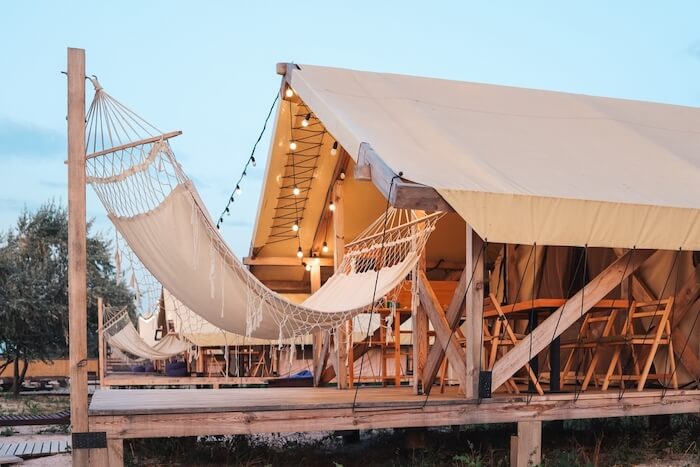
3. Secure Financing for Your Glamping Business
From using your capital savings to applying for business loans, there are different types of financing that vacation rental owners can explore.
Once you have secured financing for your new hospitality business venture, you will also need to set up a business bank account, apply for a business credit card, and register for tax.
4. Find Your Glamping Site and Apply for Land Permissions
When deciding on a glamping site in your chosen location, you will need to pay attention to a number of factors. These include:
- The popularity of the area
- If it fits in with your glamping business plan
- Nearby amenities and attractions
- Accessibility of the glamping site
- Security of the glamping site
When considering potential glamping sites, you will also need to give thought to how regulations, like zoning restrictions, safety regulations, and required permits, will impact your holiday rental.
For example, the type of unit, sanitary facilities, waste systems, and electrical installations will impact if you will be granted a license. Also, if you plan on erecting more than one unit, the spacing between the different units and access roads can be a deal-breaker.
After you have done your homework, you can contact your local authority to get planning permission (this can take as long as six months, if not more, so plan ahead). Only after you have planning permission will you be able to apply for a license.
Even though you won’t be erecting a permanent fixture, you still need to get the required licenses or permits. Skip this step and you get fined or, worse, your small business can get shut down.
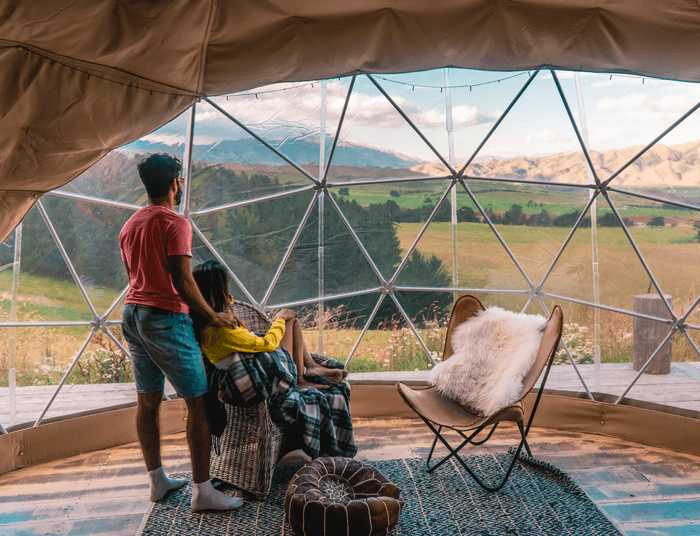
5. Research and Purchase Your Glamping Tent
The type of tent that you decide on needs to match their business plan. Since the goal is to offer a more luxurious experience than traditional tent camping, whichever tent type you decide on can’t be too small.
Be warned, some glamping tents can set new business owners back tens of thousands of dollars. So, remember what is allocated for the tent alone in your budget.
What are the essential features that it should offer? Identifying these will help you to avoid overspending when you buy tents.
You don’t want to replace the tent too often, though. This can eat away at your profit margin. To avoid buying an unreliable brand, take the time to compare the advantages and disadvantages offered by different manufacturers.
If you do have a bit of a higher budget, you can of course consider creating a custom tent design for your business. Something that will set you apart from the rest of the offerings in your area.
6. Plan Ahead with Your Facilities
In addition to planning your glamping business around the main features of your chosen tent type, you should also consider the onsite facilities offered by the site. How will you add shower and toilet facilities? What about a tent stove? These are essential for the true glamping experience.
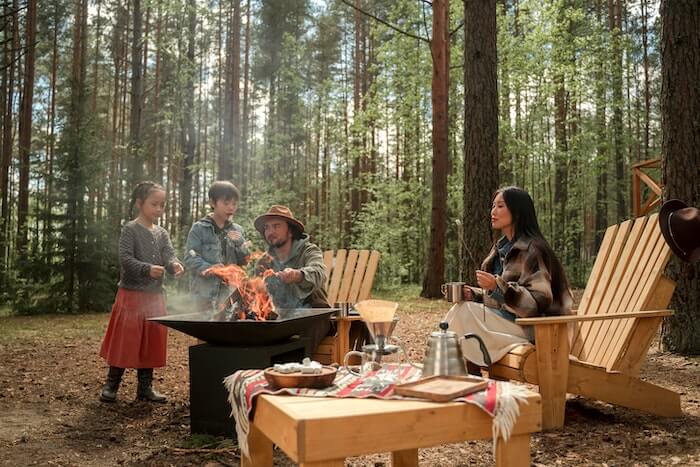
7. Kit Out Your Tent with Key Amenities and Tasteful Decor
After you have sorted out your glamping tent, and location, and you have a better idea of the facilities that you will offer, it is time to turn your attention to how you will decorate your luxury tents.
To ensure a memorable guest experience, most glamping businesses aim to strike a balance between comfort, style, and charm when filling their tents.
Whether you’re going for the shabby chic style or country-western decor is more to your taste, the following checklist is useful to ensure that nothing gets forgotten and that the final result is a tent with its own unique character that will appeal to your potential customers.
Focus on the essentials first
The essentials that your glamping setup should offer are:
- A comfortable bed
- Blankets
- Towels
- Bedside tables
- Bedside lamps
- A table/desk
- Hot stove
- Hot shower
- Chairs
- Lights
- Wardrobe (remember to include hangers)
- Mirror
- Rug
Add extras to wow your guests
To impress your glamping guests and set your tent apart from the competition, there are also certain luxury extras that you can offer. These include:
- Decorations (like colorful bunting and fairy lights)
- A campfire kit with marshmallows, recipe ideas, etc.
- Outdoor camping blanket
- Board games
- Patio heater
- Laundry room
- Handpresso coffee machine
- Folding wooden picnic table
- Picnic basket
- Outdoor pizza oven
- Hammock
- Mystical fire powder

8. Start Promoting Your Glamping Business and Drawing in Bookings
Just like you need to market any other type of business, you will also need to craft a marketing plan before you can start a glamping business. Even the most unique destinations and setups won’t attract guests if you do not have a plan for how you will get the word out.
For marketing ideas, be sure to check out our blog post 13 Vacation Rental Advertising Ideas for an Unbeatable Marketing Strategy. Whichever marketing strategies you decide to implement, the following steps are essential:
Create an enticing listing
The key elements of a good listing are a catchy title, high-quality photos, and an enticing description to draw in potential customers. To help you make the most of your listing, you can check out our checklist for how to optimize your listings and don’t forget to think through a good pricing strategy for your listings too.
List your accommodation on OTAs
It is recommended that new glamping businesses list on multiple OTAs. These platforms get loads of traffic which will help you to reach a much wider audience right from the start. For glamping accommodation, you can check out the following websites:
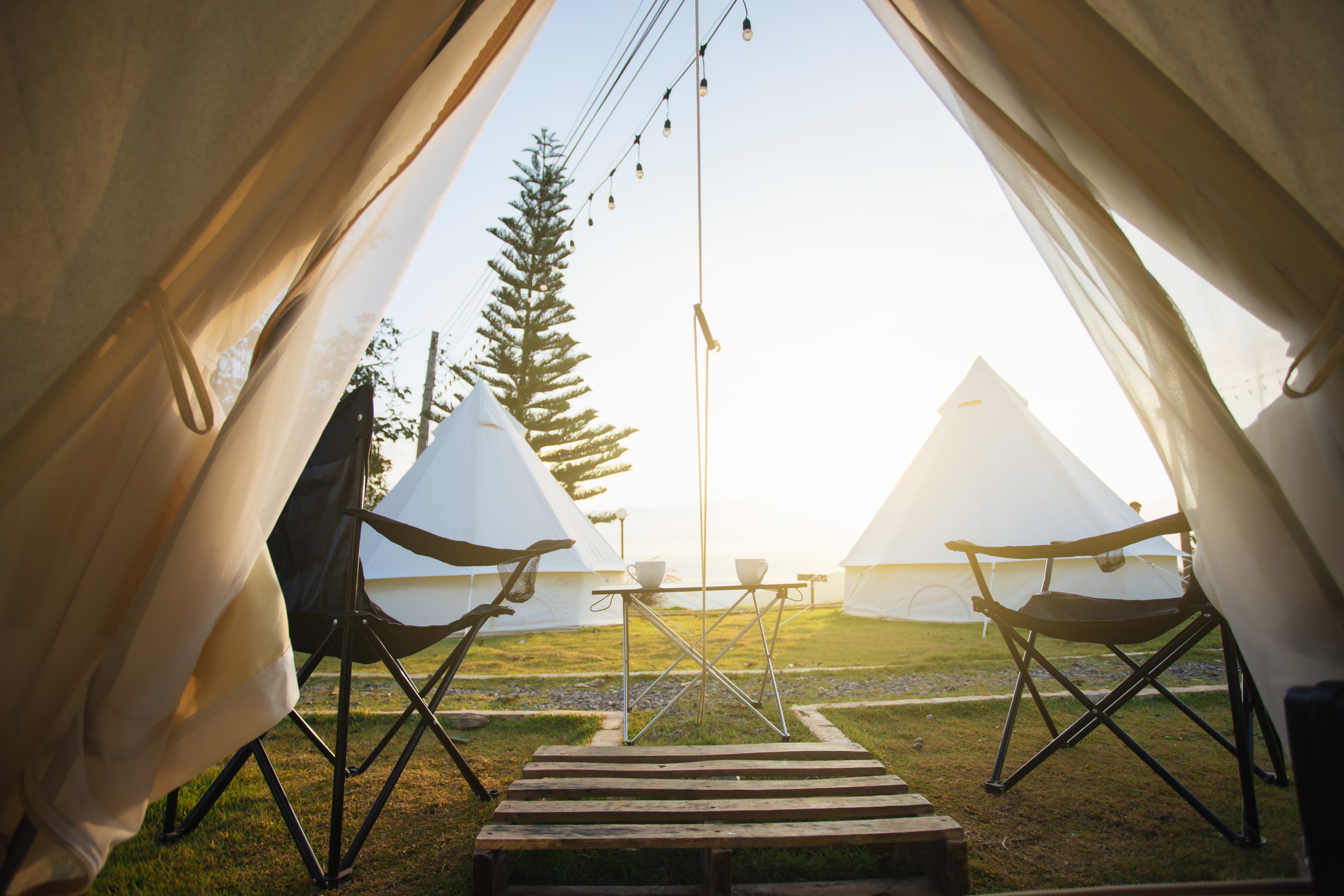
Keep all your tasks and calendars organized
It can be difficult to keep track of listings across many listing sites. It can also feel overwhelming managing guest communication and other regular tasks like cleaning, invoicing, tracking payments, etc.
For this reason, it is best also to invest in a vacation rental software solution. You can, for example, check out iGMS which can help you to manage the following routine tasks with the help of automation:
- Managing multiple accounts and listings on the major vacation rental platforms
- Organizing your messages and email into a unified inbox and using automated templates and triggered messaging to improve guest communication
- Automating the process of guest reviews
- Create your own direct booking website with the iGMS Website Builder
- Receiving payouts and creating invoices by connecting your Stripe account to iGMS
- Sharing daily cleaning schedules with your team and auto-assigning tasks.
Build an online presence
On top of listing on OTAs, another worthwhile idea that you can explore is to start your own website for direct bookings. This way, travelers can find you via search engines. What makes this an attractive avenue to explore is that you will pay service fees to OTAs less often.
Building a following on social media is also crucial. All in all, there are several well-known platforms that you can use to increase your exposure free of charge. Facebook, Instagram, YouTube, and Pinterest can all be incorporated into your marketing campaigns. And, if you are trying to attract a younger crowd, you can even use TikTok.

9. Prepare for Your First Guests
Delivering a great glamping experience is the foundation for good reviews and repeat bookings. To make the most of your amenities and extra luxury items, you also have some important tasks that include the following:
Give a warm welcome
A welcome book and welcome basket are great ways to welcome your guests, especially if you can’t be there in person to meet them. To add that personal touch, you can also write a welcome letter that you include in your welcome book.
Highlight activities to do in the area
Travelers who book a glamping site generally enjoy spending time outdoors. To help them make the most of their stay, it is best practice to highlight popular activities and attractions that the area offers.
Maintain great communication
When it comes to communicating with your guests, professionalism, and promptness are key. Your tone of voice and response rate will be two of the factors that will help your guests decide if they want to visit your luxury campsite again.
If you can’t answer a specific question, the next best course of action is to direct them to another resource that can help them.
Encourage guests to leave positive reviews
Positive reviews will help a new business owner to gain popularity and trust. If there are ample five-star reviews that interested travelers can read, they will feel much more reassured that you are the real deal and that the photos are not too good to be true.
For this reason, make it standard practice always to review your guests and ask them politely to return the favor.

The Best Ways to Ensure a Thriving and Successful Glamping Business
When it comes to starting a glamping business, there is not just one road to success. Choosing the right glamping site can be hugely critical, as well as the type of tents. There are plenty of options – bell tents, yurts, safari tents and so on.
As a glamping business owner your location and amenities will play a critical role, some extra touches can make all the difference. Here are some ideas that you can try out:
1. Offer something unique or fit into a niche
To help you set your listing apart from similar ones, it can be a good idea to offer an unusual amenity or interesting activity. You can, for example, include:
- A hot tub
- Horse riding
- Stargazing
- Guided hikes
2. Form partnerships and business relationships with fellow glamping business owners and local businesses
Instead of merely listing activities and attractions in your welcome book, you can take it one step further and start local partnerships with cultural sites and other businesses like kayak rentals, vineyards, etc. to organize special discounts for your guests. It is a win-win for all parties involved. Your guests will get a special offer, while the provider will get more customers.
What’s in it for you? Happy guests. Plus, the provider might also refer your accommodation to their customers.
3. Keep improving the guest experience
Being consistent with communication and the standard of service you provide will ensure that you always provide the best possible guest experience. This means that you need to take guest feedback seriously and stay informed about the glamping market to stay ahead of the latest trends.
4. Automate as many tasks as possible
As you have probably discovered by now, starting and managing a glamping business calls for a lot of work. After your guests have checked in, you must still be available for queries that might arise during their stay. Then, after your guests have checked out and the reviews have been written, you need to do it all over again.
To help you grow and scale your glamping business, it makes sense to automate as many tasks as possible. iGMS can, for instance, automate guest communication and reviews. Even if you use it only for this purpose, you will already free up loads of time that you can dedicate to other important tasks.

Final Thoughts
As a glamping host, you may not get everything right the first time, but you can continue to refine and improve your business and guest experience. Eventually, you will find your rhythm and your business will start to thrive.
From safari tents to bell tents, there are many different-sized tents. So, you are bound to find one for the ultimate cool camping experience.
About the Author
Callan Riddles is the Content and Social Media Specialist at iGMS. Callan has a passion for finding new ways to help vacation rental businesses thrive. In her free time, she loves to travel, read, and experience all the new things that life has to offer.







![Your Monthly iGMS Roundup [February 2020]](/content/images/size/w600/wordpress/2020/02/igms-roundup-feb-2020-cover.png)

